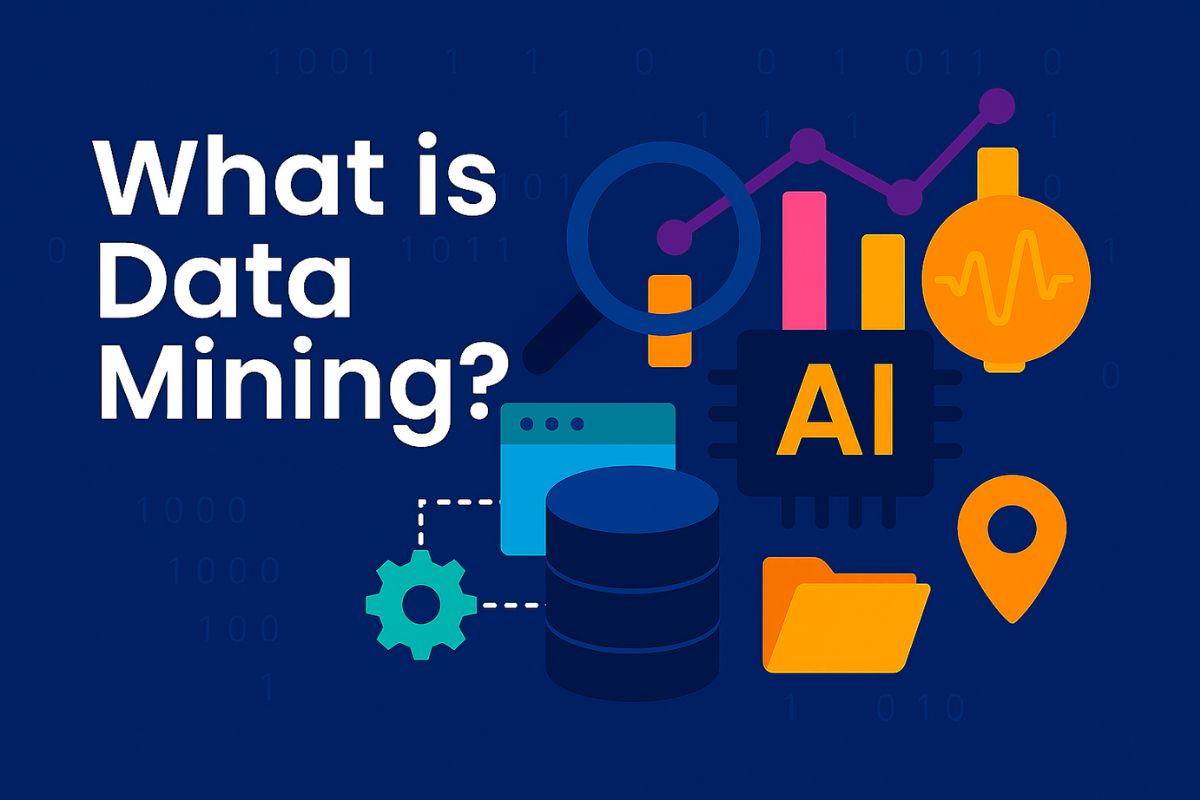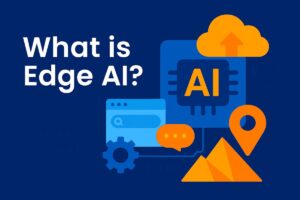Data mining is the process of extracting useful patterns and insights from large datasets using statistics, machine learning, and database systems. This 2025 guide explains what data mining is, how it works, major techniques, real-world use cases, tools, and the future of data-driven decision-making. Ideal for students, professionals, and AI learners.
Ever wondered how Netflix recommends your next favorite show or how banks detect fraud in real-time? The answer lies in data mining—a core technique in the world of data science and artificial intelligence (AI).
As we move into 2025, data mining is becoming a cornerstone of decision-making across industries. It’s more than just handling data—it’s about extracting knowledge. In this blog, we’ll break down what data mining is, how it works, the key techniques, real-world applications, and what the future holds.
What is Data Mining?
Formal Definition & Meaning
Data mining refers to the computational process of discovering patterns, trends, correlations, and insights from large data sets. It sits at the intersection of statistics, machine learning, and database systems.
Relation to KDD (Knowledge Discovery in Databases)
Data mining is a key step in the broader KDD process. The stages include:
- Data Selection – Choosing relevant data sources
- Preprocessing – Cleaning and formatting data
- Transformation – Normalizing and organizing data for analysis
- Data Mining – Applying algorithms to extract patterns
- Evaluation – Interpreting results for actionable insights
How Data Mining Works: Step-by-Step Process
Lifecycle Stages
- Data Collection – Gathering structured/unstructured data
- Cleaning & Preprocessing – Removing noise, handling missing values
- Data Transformation – Aggregation, normalization, encoding
- Pattern Discovery – Applying mining algorithms
- Interpretation & Evaluation – Validating insights
Example Workflow
Let’s say an e-commerce platform wants to reduce customer churn:
- Collect transaction and browsing history
- Clean and normalize data
- Use clustering to segment customers
- Apply classification to predict churn risk
- Use insights to offer personalized discounts
Major Data Mining Techniques
| Technique | Description | Example Use Case |
|---|---|---|
| Classification | Predict labels from input data | Spam email detection |
| Clustering | Group similar items without labels | Customer segmentation |
| Association Rule Mining | Identify relationships or correlations | Market basket analysis |
| Anomaly Detection | Find rare patterns or outliers | Credit card fraud detection |
| Regression | Predict numeric values | Sales forecasting |
| Text Mining & NLP | Extract info from unstructured text | Sentiment analysis on reviews |
| Graph/Data Stream Mining | Analyze evolving or large-scale data streams | Social network analysis, IoT |
Real-Life Applications of Data Mining
Business & Finance
- Fraud detection in banking
- Credit scoring and risk modeling
- Customer lifetime value prediction
Healthcare
- Predicting disease outbreaks
- Diagnosing diseases through imaging patterns
- Clinical trial analysis
E-commerce & Marketing
- Recommendation engines (Amazon, Netflix)
- Customer segmentation
- Predicting churn and optimizing promotions
Telecom & IoT
- Network fault prediction
- Call drop analysis
- Usage pattern recognition
Environment & Agriculture
- Analyzing satellite data for weather patterns
- Monitoring crop health using drones
- Predictive analytics for water resource management
Traditional vs Advanced Data Mining
| Aspect | Traditional Methods | Modern/AI-Driven Techniques |
| Tools | SQL, Excel | Python, R, AutoML platforms |
| Algorithms | Decision Trees, KNN | Deep Learning, GNNs |
| Data Volume | MB to GB | TB to PB |
| Processing | Batch | Real-time / streaming |
| Deployment | Manual scripts | Cloud & Edge AI |
Future Trends in Data Mining
Emerging Trends
- Federated Data Mining – Preserves privacy by training on decentralized data
- Graph Neural Networks (GNNs) – Extract complex relationships from social, biological, and knowledge graphs
- Multimodal Mining – Analyze combined image, audio, text data
- Streaming Analytics – Handle continuous data from sensors or apps
- AutoML & No-Code Tools – Democratize data mining for non-programmers
Career Outlook
- Roles: Data Mining Engineer, ML Engineer, BI Analyst
- Certifications: Google Data Analytics, IBM Data Science, Udacity Nanodegree
Benefits of Data Mining
- Improved Decision-Making – Data-driven business intelligence
- Pattern Recognition – Find hidden trends and correlations
- Operational Efficiency – Reduce costs and resource wastage
- Risk Management – Early detection of threats and fraud
- Customer Satisfaction – Hyper-personalized experiences
Challenges & Ethical Concerns
Data Privacy & Governance
- GDPR, HIPAA, India’s DPDP Act mandate strict data handling rules
Bias & Fairness
- Biased training data can lead to unfair decisions (e.g., loan rejections)
Scalability
- Need for big data processing tools and infrastructure
Data Quality
- Inaccurate/incomplete data reduces model performance
Expert Tips to Learn Data Mining
- Start with Python and SQL basics
- Use tools like Scikit-learn, Orange, and Weka
- Practice on real datasets from Kaggle, UCI, or Data.gov
- Follow blogs like KDnuggets, Towards Data Science
- Join data science communities on Reddit, Discord, and LinkedIn
Tools & Free Resources
| Tool | Use Case | Link |
| Orange | Visual programming for data mining | https://orange.biolab.si |
| RapidMiner | GUI-based data mining workflows | https://rapidminer.com |
| Weka | ML for data mining tasks | https://www.cs.waikato.ac.nz/ml/weka/ |
| Kaggle | Public datasets & competitions | https://www.kaggle.com |
Conclusion
Data mining empowers individuals and organizations to make better, faster, and more intelligent decisions. As AI continues to evolve in 2025 and beyond, data mining will remain a key enabler of insight, innovation, and impact.
Whether you’re a student aiming for a tech career or a business leader looking to leverage data, mastering data mining can give you a significant edge.
Explore more blogs on Schoolication to continue your learning journey.
FAQs
Q1. What is data mining in simple terms?
Data mining is the process of discovering useful patterns and insights from large amounts of data using algorithms and tools.
Q2. What are the main steps in data mining?
They include data selection, cleaning, transformation, mining, and interpretation.
Q3. Which industries use data mining the most?
Finance, healthcare, retail, telecom, and agriculture widely use data mining.
Q4. Is data mining the same as machine learning?
No. Data mining uses ML algorithms but focuses on knowledge discovery from data.
Q5. What tools can I use to learn data mining?
Popular tools include Orange, Weka, Scikit-learn, and platforms like Kaggle.
Q6. Is data mining ethical?
It depends on how data is used. Ethical mining requires compliance with privacy laws and fair algorithms.
Q7. Do I need coding skills to learn data mining?
Not necessarily. Tools like Orange and RapidMiner offer no-code interfaces for beginners.



